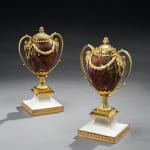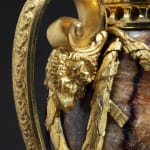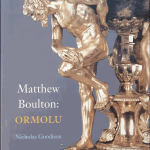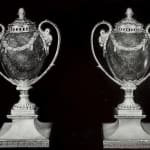AN IMPORTANT PAIR OF GEORGE III BLUE JOHN PERFUME BURNERS BY MATTHEW BOULTON
Width: 6.5" / 17cm
Depth: 4.5" / 11cm
Further images
Publications
Illustrated in Nicholas Goodison, Matthew Boulton: Ormolu (London: 2002), p. 305, pl. 279
An important pair of George III Blue John, marble and ormolu-mounted perfume burners of ovoid form by Matthew Boulton and John Fothergill, each with a domed foliate lid with a flower bud finial above a pierced rim and mounted with scrolling foliate handles with ram’s head terminals, hung laurel garlands, and ribboned oak leaf swags above a fluted socle on a stepped square foot with an egg and dart border, in turn on a white marble waisted socle with a Vitruvian scroll-cast ormolu band.
Matthew Boulton and Ormolu
Matthew Boulton was one of the most important figures of the eighteenth century. An industrialist, pioneer of precision manufacturing technologies, revolutionising the minting of coinage and a father of the steam engine, he played a major part not only in the development of the British economy but the wider industrialisation of the world.
In addition to these achievements, however, Boulton is renowned for his production in his manufactory at Soho, Birmingham of some of the finest decorative artworks in Europe, of which this pair of perfume burners is a leading example.
Opening his Soho manufactory with his partner John Fothergill in 1762, with revolutionary innovations in manufacturing methods and labour division Boulton expanded beyond the production of buttons and other ‘toys’ to encompass a wide variety of luxury objects, becoming, as Josiah Wedgewood commented in 1767, 'the most complete manufacturer in England in metal’.
In 1768, ‘at the request of some of our nobility’, Boulton began to produce works in ormolu, and capitalising on the craze for the ‘antique’ taste which exploded during the 1760s, specialised in vases, choosing to form the shape of the rare Derbyshire fluorspar, Blue John.
This pair of perfume burners embodies the incredible popularity and success of Boulton’s designs. A particularly classic and elegant model, this pair’s even sweeping shaped arms and waisted socle lend the urns lovely grace. For the base to be of white marble is a highly effective complement to the gilt metal and deep purple Blue John and is a rare feature. The Blue John is from a strong seam and is well-striated.
In the 1770s, when this pair was made, Boulton’s reputation for decorative works in ormolu was second to none. In the words of a contemporary, the publisher M. Swinney, his ornaments were ‘admired by the nobility and gentry, not only of this kingdom, but of all Europe’. In his own words, he sold ‘what all the world desires’.







